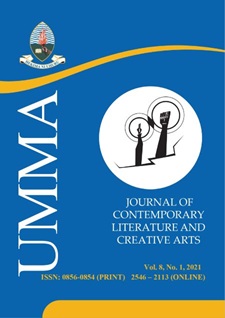Symbolism and Death: Class-based Ritualised Performance in the Basukuma Burial Ceremonies
Abstract
Guided by a Marxist perspective on literature, and Muleka ' s Performer-centrism, this paper highlights and discusses different manifestations or gestures that covertly suggest that there are elements of classes in some of the burial ceremonies, which are accompanied by performances among the Basukuma ethnic group of Tanzania. It reports the findings of a study whose data were collected using interviews held with respondents selected via snowball sampling. Note-taking served as a prominent data collection tool. Documentary review supplemented interviews, especially to collect data on the traditions of the Basukuma as one of the ethnic groups in Tanzania found predominantly in the Lake Victoria Zone. The study found that the burial ceremonies of the Basukuma are class conscious as manifested by their symbolic, incantatory, and invocatory performances. Indeed, when chiefs, singers, breech-birth and twins die, their burials require special burial ritual performances such as incantations, invocations and symbols that differentiate them from other rank and file individuals whose burial ceremonies lack fanfares characterising privileged individuals. Overall, these burial ceremonies graced by symbolic gestures among the Basukuma also help to unify the community since individuals define themselves in terms of who they are and what to expect from them and the community as a whole. https://dx.doi.org/10.56279/ummaj.v9i2.5
References
Avineri, S. 1968, The social and political thought of Karl Marx, Cambridge at University Press, London.
Baloyi, L. 2014, "The African conception of death: a cultural implication". Accessed online at https://scholarworks.grsu.edu>cgi>viewcontent
Finnegan, R. 1970, Oral literature in Africa, Clarendon Press, Oxford.
Jefferson, A. & Robey, D. (Editors), 1997, Modern literary theory: a comparative introduction, B.T. Batsford Ltd, London.
Hatfield, R. 1965, The Nfumu in tradition and change: the study of position of religious practitioners among the Sukuma of Tanzania, East Africa. Unpublished PhD Thesis, Catholic University of America, Washington DC.
Kothari. 2009, Research methodology methods and techniques, New Age International Publishers, New Delhi.
Makoye, H. 2003, The dance culture of Sukuma of Tanzania, Unpublished PhD Thesis, University of Ghana, Legon.
Mtaku, Y. 2016, Twin ritual (Kamta Bulikur): the significance of traditional music in the health and wellbeing of twins among the Bura of North-eastern Nigeria, Legon Journal of the Humanities, vol. 27, no. 1, pp. 96- 105.
Muleka, J. 2014, Theory in the study of African oral literature: the Oral artist agenda, Accessed online at https://www.theatrsjournals.org>article>download
Nwokoha, P. 2020, "Rites and Rituals for the Dead: Bases for Good Moral Behaviour in Ezzaland, Nigeria", International Journal of Religion & Human Relations, vol. 12, no 1, pp. 67 -85.
Okpewho, I. 1992, African and literature, background character and continuity, Indian University Press, Bloomington, IN.
Selden, R. et al. 2005, A reader ' s guide to contemporary literary theory, Pearson Longman, London.
Shiino, W. 1997, Death and Rituals among the Luo in South Nyanza, African Study Monographs, vol. 18, no. 3 & 4, pp. 213-228.
Songoyi, M. , 2005, The form and content of the Wigashe dance songs of the Sukuma, Unpublished PhD Thesis, University of Dar es Salaam.
Zampi, P. 2001, Enculturating African widowhood rites, Unpublished MA Dissertation, CT, Cape Town.
Downloads
Published
Issue
Section
License
- Authors retain copyright and grant the journal right of first publication with the work simultaneously licensed under a Creative Commons Attribution License that allows others to share the work with an acknowledgement of the work's authorship and initial publication in this journal.
- Authors are able to enter into separate, additional contractual arrangements for the non-exclusive distribution of the journal's published version of the work (e.g., post it to an institutional repository or publish it in a book), with an acknowledgement of its initial publication in this journal.
- Authors are permitted and encouraged to post their work online (e.g., in institutional repositories or on their website) prior to and during the submission process, as it can lead to productive exchanges, as well as earlier and greater citation of published work (See The Effect of Open Access).



